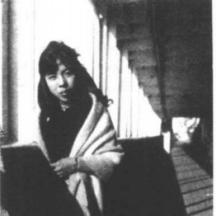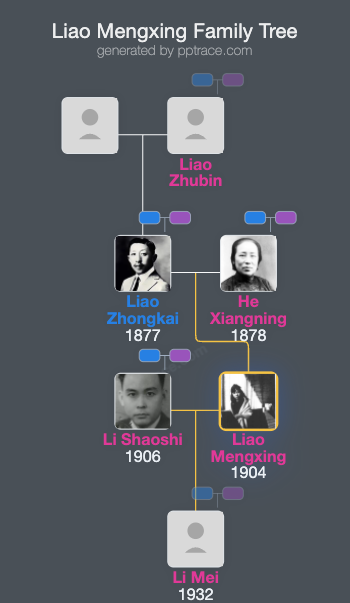
Liao Mengxing
| Name | Liao Mengxing |
| Title | Chinese female political activist |
| Gender | Female |
| Birthday | 1904-00-00 |
| nationality | People's Republic of China |
| Source | https://www.wikidata.org/wiki/Q8248593 |
| pptrace | View Family Tree |
| LastUpdate | 2025-02-28T08:50:37.624Z |
Introduction
Liao Mengxing, born on February 4, 1904, in Huiyang, Guangdong (now Xingfu Village, Zhongkai Chenjiang Subdistrict), was a prominent revolutionary figure in modern China, with extensive political and social influence. Her father was Liao Zhongkai, a pioneer of the democratic revolution, and her mother was He Xiangning, a trailblazer in women’s movement and democratic revolution. She was also one of the early members of the Chinese Communist Party, served as Long-term assistant to Soong Ching-ling, and made significant contributions to China’s united front and diplomatic work.
Liao Mengxing came from a deeply influential family. Her father, Liao Zhongkai, was a key figure in the cooperation between the Chinese Communist Party and the Kuomintang, serving as Deputy Minister of Finance in the Provisional Military Government and as Director of the Guangdong Provincial Finance Department, becoming a standing member of the Central Committee of the Kuomintang in 1924. Her mother, He Xiangning, was a distinguished political activist and pioneer of women’s movements. The family’s influence motivated Liao Mengxing from a young age to join anti-imperialist and anti-feudal movements, influenced by her parents’ revolutionary spirits. Her name, "Mengxing," symbolizes the awakening of the Chinese nation from slumber.
In 1923, she was admitted to the Department of Sericulture at Lingnan University and actively participated in student movements. After the establishment of the Nationalist government in 1925, she began to establish connections with the Communist Party, gradually deepening her revolutionary work. In 1926, she accompanied her family to the Northern Expedition battlefield and later returned to Guangzhou to continue revolutionary activities. In 1928, she married Li Shaoshi and began underground liaison work. That same year, she secretly joined the Chinese Communist Party, playing an important role in the party and revolutionary efforts.
By 1933, she was working in the publicity department of the Jiangsu CPC Committee, serving as an interpreter for the "China Workers' News Agency," translating documents such as land reforms and constitutional laws. During the Second Sino-Japanese War, she actively participated in the anti-Japanese salvation movement, working in Shanghai and Hong Kong to raise supplies and promote anti-Japanese propaganda. In 1941, after moving to Chongqing, she became Secretary and Deputy Minister to Soong Ching-ling, responsible for liaison and intelligence transmission, supporting underground work for the Communist Party.
After the founding of the People's Republic of China, Liao Mengxing served successively as Deputy Director of the International Department of the All-China Women's Federation, a National People's Congress deputy, and a Chinese People's Political Consultative Conference member. She also served as a director of the World Peace Council and the China-Japan Friendship Association, and as an honorary museum director of the Soong Ching-ling Foundation. Through her influence in various domestic and international organizations, she promoted national unification and national rejuvenation. Her career spanned politics, women's work, and international exchange, making significant political and social contributions.
Liao Mengxing’s family background added significant political depth to her life. Her brother, Liao Chengzhi, was an outstanding proletarian revolutionary and a leader of the Communist Party and the state. Her daughter, Li Mei, inherited the family’s revolutionary spirit and grew into an important revolutionary successor. Her life was centered on dedicated service to the revolutionary cause, holding an important position in politics, diplomacy, and women’s work. She passed away in Beijing in 1988 at the age of 84.
Family Tree
Tap to expand more relatives
